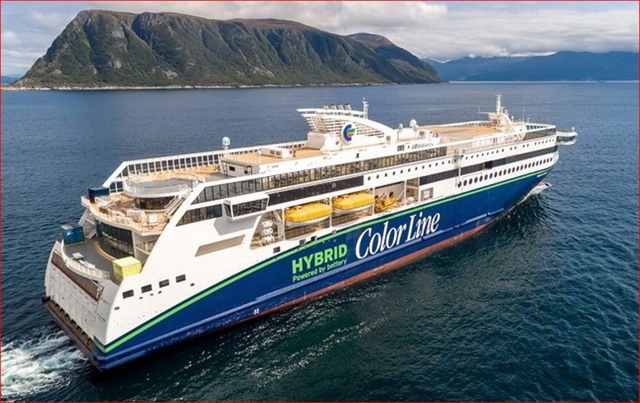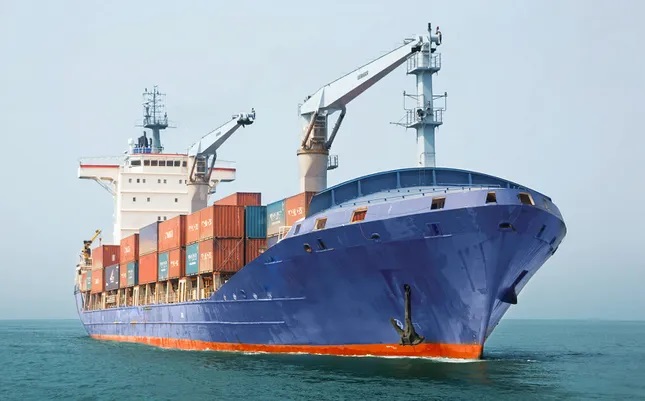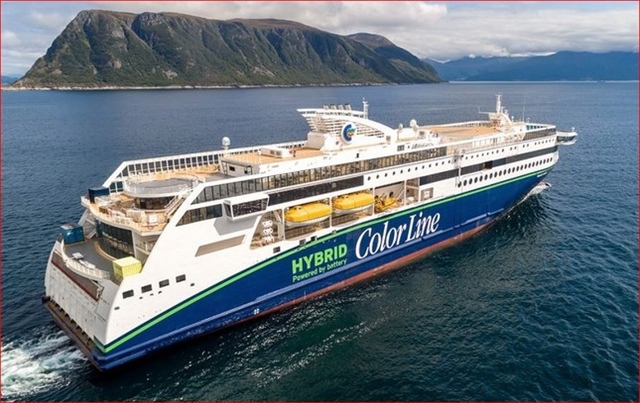The United Nations (UN) reports that the maritime shipping industry transports approximately 90% of global trade, accounting for nearly 3% of global greenhouse gas emissions. This amounts to about 1 billion tons of CO2 and other greenhouse gases annually, which would rank the industry as the sixth largest polluting country if it were a nation-state. If left unchecked, emissions from maritime shipping are projected to reach 90-130% of 2008 levels by 2050.
In a landmark agreement reached in late April, members of the International Maritime Organization (IMO) agreed to implement measures to curb greenhouse gas emissions from ship operations after years of tense negotiations.
As per the agreement, ships will be charged a fee of 380 USD for each ton of CO2 emitted beyond the allowed threshold. Additionally, vessels that exceed the higher emission cap will be subject to an extra surcharge of 100 USD per ton.

Ships may be subjected to a fee of 380 USD per ton of excess CO2 emissions. Image: Ulstein. |
The revenue generated from these emission charges will be channeled into the IMO’s Net Zero Fund, estimated to amass a substantial 40 billion USD by 2030. This fund will subsidize zero-emission fuels and technologies, provide financial incentives for vessels operating with minimal or zero emissions, and support innovative initiatives, research, infrastructure development, and transitions in developing nations.
According to the UN, if the draft regulations of the IMO agreement are formally adopted in October this year, the green solutions for the maritime industry will come into force by 2027.
As a rapidly growing export-oriented economy heavily reliant on maritime trade, with over 90% of its exports being shipped, Vietnam is expected to be significantly impacted by the IMO’s agreements on carbon pricing and emission standards.
Data from Vietnam’s Department of Marine and Inland Waterways reveals that the average age of the country’s current fleet is over 17 years, surpassing the global average. Most vessels built before 2020 are not equipped with energy-saving technologies, emission control systems, or optimized hull designs to reduce fuel consumption. Consequently, the implementation of carbon taxes is likely to result in elevated operational costs for shipowners, eroding their profit margins.

Carbon taxes may lead to increased operating costs for shipowners, impacting their profitability. Image: VIMC.
|
Amid the ongoing tariff tensions, Vietnam’s key export commodities, including agricultural produce, seafood, furniture, electronics, and garments, are highly price-sensitive in the global market. Hence, elevated shipping rates due to carbon costs could hinder the competitiveness of Vietnamese goods in international markets, particularly in regions with stringent environmental standards such as Europe and North America.
To meet emission reduction targets, vessels will also need to transition to low-carbon or zero-emission fuels like green methanol, ammonia, or hydrogen. However, Vietnam currently lacks the necessary infrastructure and supply chain for these alternative fuels, presenting a significant challenge.
Confronted with these pressing imperatives, shipowners must diligently analyze and calculate their options for compliance. Procrastination in fleet upgrades and technology adoption will result in eroding market share and could even lead to exclusion from global supply chains.
|
In response to the urgent demands of the industry’s greening process, the Vietnam Maritime Corporation (VIMC) has devised a strategy for investing in a “green” fleet during 2025-2030. VIMC will prioritize investing in new-generation vessels that are fuel-efficient and environmentally friendly, while actively phasing out older ships that fail to meet IMO environmental standards and exhibit low operational efficiency. |
Loc Lien
– 07:51 06/07/2025
“20,000 Hectares of Rice Fields in Nghe An Embrace Innovative Farming: A Step Towards Greener Rice for Global Palates.”
“The innovative alternate wetting and drying irrigation model has proven its success in Nghe An province, with over 20,000 hectares of land now utilizing this method. This sustainable practice has led to a remarkable reduction of over 50% in greenhouse gas emissions and has also conserved water resources, boosted rice yields, and created opportunities for farmers to increase their income through carbon credits and the export market for this ‘green rice’.”
What is the Significance of MRV in the Journey Towards Carbon Credits?
In the quest for carbon credits, the MRV (Monitoring, Reporting, and Verification) process plays a pivotal role. It is not merely a technical procedure but a crucial refining step that determines whether a project receives carbon credit accreditation.
Why Are Many Businesses Buying Carbon Credits Instead of Reducing Emissions Themselves?
In the midst of a growing global push for Net Zero commitments, the carbon credit market is experiencing a surge in demand from businesses. A prevalent trend sees companies opting to purchase carbon credits as an alternative or supplementary solution, rather than solely focusing on direct emission reductions in their production operations. This development raises questions about the motivations behind these decisions and the potential implications for the trajectory towards achieving net-zero emissions by 2050.














































